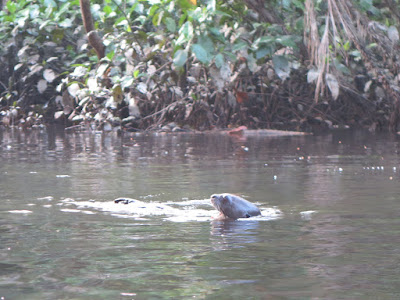So far I had the opportunity to backpack on a shoestring through Europe, Asia, South America, North America and North Africa. After every trip I take mental notes about items I should include or take off my list. I'm an organization freak! So here are some packing tips for an amazon jungle trip.
 |
| View over deforested Coca |
I've done jungle trips before. When it came time to pack for the Napo Wildlife Center I already knew what I was looking for.
Any sense of fashion and style will go out of the window the second you step off the plane and begin to sweat abundantly. In this type of trips you want to feel comfortable and protected from sunburns and insects.
 |
| River otter |
- Long Sleeves
You'll need 2 long sleeve dry fit shirts in light colors (pastel tones are the best) but on a looser fitting. This is a very hot and humid place, you'll be always wet and sticky. Loose fitting clothing is comfier.
I noticed that all the guides were wearing Columbia long sleeve shirts. Those are baggy shirts made with a very light and breathable fabric.
- T'shirts
I got some dry fit tanks but they weren't appropriate. My skin was too exposed. T'shirts are a better choice. Or at least tanks that cover your chest and shoulders.
 |
| Nocturnal frog |
- Pants
In Costa Rica, I was wearing cotton leggings and they weren't cushy. The fabric wasn't breathable, it was wet all the time and I got lots of mosquitoes bites. This time, I bought some roomy ultra light pants. Unfortunately, I couldn't find these in a light color. But they worked fine.
- Shoes
Sneakers are the safest option (some guests were wearing Keen hybrid shoes, they were ok too). The lodge will provide you with Wellington boots for the muddy treks (they were comfortable, I didn't need to use the shoe insoles recommended by some reviewers on Tripadvisor).
- RainJacket
The lodge provides long ponchos. No need to pack one.
 |
| David, our eagle-eye, trying to spot wildlife while paddling |
- Basics
You'll also need clothing to wear around the lodge. I packed a couple of basics: cotton dress and shorts plus flipflops. Nothing fancy or trendy. Just comfy clothes.
- Acessories
A wide brimmed hat like this one is mandatory. And sunglasses.
Don't forget to bring a small backpack to carry the essentials for the daily activities.
Binoculars make a big difference in these nature trips. Otherwise it is really hard to spot wildlife or fully enjoy it. We decided to buy a decent pair of 10x42mm waterproof and fogproof binoculars, still reasonably priced. They performed greatly.
We packed a flashlight but it was useless. We ended up using the iPhone for that. Way better!
 |
| Birding |
- Toiletries
The Sun is very strong in the Equator. Bring a good sunscreen with a high SPF.
I packed a Deet based insect repellent (I tried many natural alternatives but they weren't effective in jungle) but I barely used it during my stay. Napo is almost a mosquito - free zone (it's impressive, I only got a couple of tiny bites).
Sulfate free shampoo and toothpaste should be in your list. I also bought an all-natural soap bar but rooms had a bio- degradable shower gel dispenser.
- Compression bags
I read many complains about stinky clothes. That's why I bought some compression bags at Marshalls (I like the Swiss Gear ones). But I didn't need them for any other purpose other than saving space - they are very efficient for that. During our stay at Napo it didn't rain and there wasn't that earthy jungle smell.












